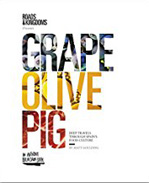
 |
Grape Olive Pig: Deep Travels Through Spain’s Food Culture
by Matt Goulding
Harper Wave/Anthony Bourdain Books
Spain is a conundrum. Married to the past, modernized by the European Union, unified and fractured by blood and history, it is a country that embraces both common and diverse cultures with grace. It’s a happy family about to burst into a bitter feud at any moment, but the food and lifestyle that surrounds it is as good as it gets in Europe while coming off as deceivingly simple. This landscape is covered in Goulding’s excellent tour of Spanish food and living from top to bottom and east to west. However, the book after all is titled, Grape Olive Pig, and so let’s begin there, folding in Goulding's observations along the way.
Spanish wine—the grape part of the discussion—is misunderstood and misclassified in America. As they say in Spain, they need to do a better job of advertising their varietals, at least as good of a job as they do in France or Italy. Keep in mind, there have been times when Spain provided grapes to France due to vine disease or France would have had no wine to drink. Always seeking simplicity and the perfect note, Spanish wine covers the palate as well as any country’s offerings, but if wine is something you prefer to drink with food, cava—Spain’s answer to champagne—is what to drink everywhere else. There’s a cava for every taste and budget, and it’s sold in stores beside soda pop and water. So much so that you might think Spaniards drink cava instead of water. Well, some do.
Olives are the thing you get while awaiting a meal, although they could be served as part of a tapas spread. This makes them seem like a second thought, but this is in no way true. The olive has been mastered in this country, and they are reason enough to return. They are stuffed, pitted, or served au naturale and on the stem, but they aren’t cured to the extent of their Italian cousins. This exhibits a fundamental attitude about Spanish cooking: Leave the ingredients alone; seek out the freshest and finest, and let them do their best work unmolested. The elements of a Spanish meal are easily identifiable, leaving no place for them to hide and nary a cover-up.
The way in which Spaniards prepare the pig is second to none. Italians will argue, but this reviewer has gotten down and dirty with both and gives the edge to Spain, although either one would leave you in porcine bliss. Again, the start is paramount to success. The black-footed ibérico pig—free-ranged and fed a diet of acorns—serves up the finest sausages and hams on the planet. The varieties are complex, succulent, and individual signatures of Spain's regions.
In this cultural guide and musings, Goulding, an expat and resident of charming and accessible Barcelona, circumnavigates Spain’s regions and serves up history and food through both personal and cultural reflection. Spain’s pivotal importance in western culture requires a wide-angle lens, but to provide illumination, the author drops into details at just the right moment to offer the essence of each stop along the way. He reiterates the culture’s emphasis on simple, fresh market ingredients—a salad consists of just-picked lettuce, liberally applied olive oil, and salt; paella requires saffron rice, salt, pepper, and the right pan and staples to determine its outcome; meat is freshly butchered and simply grilled with little and often no seasoning; and dozens of tempting variations build up from olive oil and tomato smeared bread.
This is not Goulding’s first rodeo on the food tour. He’s an experienced chef and columnist, who’s written a similar food memoir in Rice Noodle Fish, also plumbing the elemental nature of travel experience within the local cuisine. So watch out. He’s got more to say about what you might eat in the future. However, you’re not going to stick this book among your cookbooks, and you’re not going to place it on your bookshelf beside Como agua para chocolate. You’re going to drop it on your coffee table and invite friends to take it home, but then bring it back. Promise?
In a time when it seems as if the art book is giving way to mass-produced paperbacks that disintegrate faster than an Antarctic ice shelf, the hard cover production of Grape Olive Pig is gorgeous, a labor of love with an engrossing layout and beautiful photos, graphics, and lettering. The writing reveals intimate knowledge of Spanish food, but hooks you with a shared memoir that kisses the line of overly personal but never crosses it. That’s the tease that keeps this book moving forward and allows you to see the overview of Spanish cuisine while making sense of it. This book is perfectly composed, with the just the right and freshest ingredients.
RECOMMENDED by the US Review
Next Focus Review
Previous Focus Review